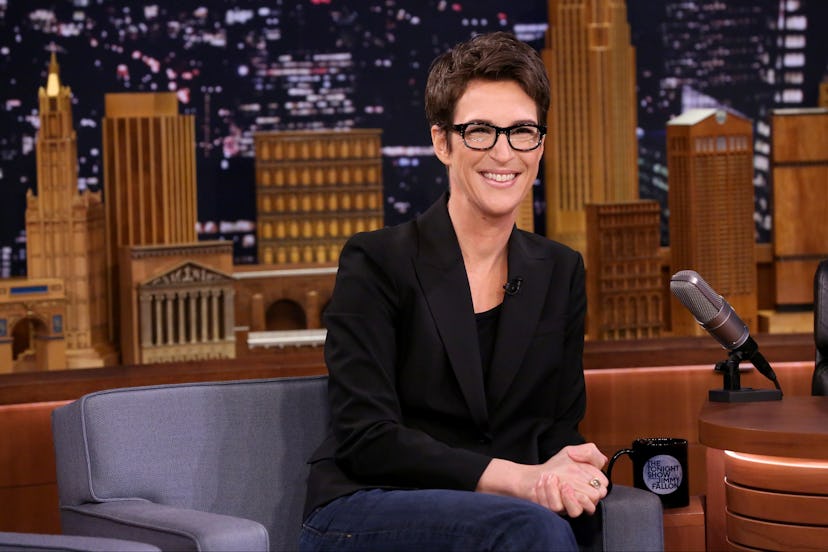The News Is Bad, But the TV Hosts’ Homes Are Entertaining
The news is bad. Analyzing what's in the background has become a source of fascination.

I don’t remember anything anyone said on Fareed Zakaria’s show on CNN last Sunday. I don’t remember much of what anyone says on TV these days, and I’ve watched more cable in the past month than I have in years. I’m too focused on what’s behind everyone to process any other information.
For a panel discussion about the future of lockdowns and the economic impact of the coronavirus pandemic, Zakaria invited the New York Times columnist Paul Krugman, the Economist editor Zanny Minton Beddoes, and political scientist Ian Bremmer, all of whom were streaming live from their homes.
Krugman, earbuds firmly in place, sat at a slight angle in front of a modernist staircase and a table covered in all manner of clutter: colorful blown glass vases, wire-frame file boxes, candlesticks. At one point in the broadcast, the Nobel Prize-winning economist took a sip from a mug that said “Shut Up and Deal With It,” designed in the style of those “Keep Calm and Carry On” posters.
In contrast, Beddoes spoke to us from what appeared to be an elegant library, subtly but not dramatically lit, the spines of hardcover books interspersed with silver-rimmed photo frames, the camera aligned perfectly with the lines of the shelves.
Bremmer, meanwhile, had his computer positioned by a window, a teal armchair just visible behind him. A neutral setup, but there appeared to be some kind of wooden slab leaning against the window frame, the exact function of which I couldn’t quite make out but spent minutes trying to.
In an era of Zoom meetings, streaming workout classes and gratuitous Instagram Lives, we’ve gotten an unprecedented look into the homes of colleagues, fitness instructors, world-famous DJs, bored celebrities and internet-favorite comedians. But the medium that has been affected most dramatically by social distancing is television, which has been dominated by the same bland, floodlit aesthetic for decades.
Instead of the glowing LED non-place of your standard broadcast studio, we’re now getting a rare whiff of individual taste, and an opportunity to engage in some armchair psychology as it pertains to theories of self-presentation. There are those for whom the particulars of framing a flattering, aesthetically interesting shot seem to come naturally (for example, Beddoes). Then there’s this grey area: Do the people who log in from a weird corner with a bunch of detritus in the background (Krugman) not care about what it looks like? Or are they trying to project the sense that they’re the kind of person who is too busy and important to care about such frivolity? Or—and this is what really keeps me up at night—are they trying to play down the signifiers of wealth that might otherwise sneak into the frame if they were to set up shop in their offices or living rooms? Then, there’s what I like to think of as the chaotic neutral (Bremmer), in which it’s clear the person has gone to some lengths to put themselves in front of a nondescript background, but something strange, funny, or just impossible to make out remains.
The news itself is, of course, devastating. But the experience of watching it has become thrillingly voyeuristic. The sport of analyzing the amateur set design endeavors at play has become a sort of balm for the content itself.
CNN anchor Chris Cuomo has been broadcasting from home since he tested positive for Covid-19, positioning his camera in front of a setup that can best be described as slightly…off. (Why is there an armchair directly in front of the foot of the stairs?) On a recent segment on Rachel Maddow’s MSNBC show, House Speaker Nancy Pelosi addressed the audience in front of an abstract canvas, parts of what appeared to be a trumpet and a football visible on the far edges of the screen. On BBC News, home of the most famous streaming gaffe in television history (remember when Professor Robert Kelly’s kid stomped into the shot? Simpler times), anchors have been reporting from hand-built backdrops: Katty Kay shared a behind-the-scenes photo on Twitter of her cozy basement nook, with a camera helmed by her son.
When it comes to late-night TV and daytime talk shows, hosts have leaned even more heavily into the personality element—but it feels more calculated, more deliberately produced, and therefore less interesting. Trevor Noah received so many emails and comments about his choices in home decor that he addressed them on camera. Samantha Bee, in a promo for her homebound production shot in the woods behind her house, joked that she’d enlisted her kids to help with cameras and lighting. The Wendy Williams Show is now Wendy @ Home; Williams addresses her audience from her kitchen table, with a truly bizarre array of art and decor visible behind her.
All this variety is a welcome distraction, something to zone out with while trying to make sense of just how bad it is. Maybe if all things were normal, seeing a glimpse of a Bloomberg contributor’s record collection or a CBS anchor’s framed family photos would seem banal. Now it feels refreshingly human. I’ll take a sideboard covered with plants over a green screen backdrop of the Manhattan skyline any day.